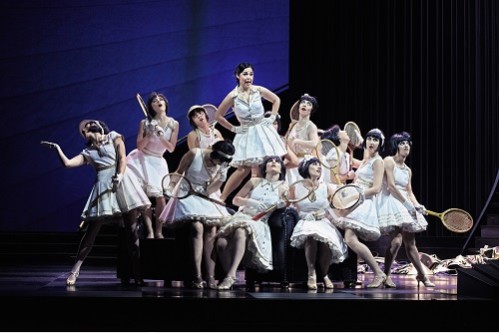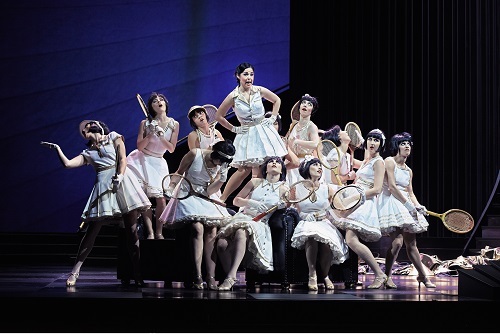 Switzerland Lehár, The Land of Smiles: Soloists, Chorus of the Zurich Opera, Philharmonia Zurich / Fabio Luisi (conductor), Zurich Opera, Zurich 19.6.2017. (JR)
Switzerland Lehár, The Land of Smiles: Soloists, Chorus of the Zurich Opera, Philharmonia Zurich / Fabio Luisi (conductor), Zurich Opera, Zurich 19.6.2017. (JR)

Cast:
Prince Sou-Chong – Piotr Beczala
Lisa – Julia Kleiter
Mi – Rebeca Olvera
Count Gustav von Pottenstein – Spencer Lang
Tschang – Cheyne Davidson
Chief Eunuch – Martyn Zysset
Production:
Producer – Andreas Homoki
Set – Wolfgang Gussmann
Assistant set design – Thomas Bruner
Costumes – Wolfgang Gussmann, Susana Mendoza
Lighting – Franck Evin
Video – Tieni Burkhalter
Chorus master – Ernst Raffelsberger
Choreography – Arturo Gama
Dramaturgy – Kathrin Brunner
A number of opera houses around the world have, in recent years, decided to expand the range of works they stage in an attempt to keep audiences happy, widen their out-reach, and, I suspect, boost flagging finances. I will not enter the well-worn debate about whether they should or should not do so; an opera house season is a package which has something for everyone and must therefore be a mixed bag. A Porgy and Bess, a Merry Widow, a Sweeney Todd all belong on the palette.
Zurich Opera has started the process, not with Lehár’s most famous operetta The Merry Widow, but with his The Land of Smiles, in German Das Land des Lächelns. It’s not an operetta many opera-goers will know but I guarantee they will all know its hit tune, immortalized by the much revered Richard Tauber, “Dein ist mein ganzes Herz” (“You are my heart’s delight”); Lehár knew he was on to a winner and ensured the tenor sings it twice during the operetta. As Fabio Luisi puts it in the programme, operetta composers are the forefathers of pop music, or the “art of the three minutes”, finding a melody which instantly gains recognition for the listener.
The problem with this Homoki production is whether to play the work straight or as a send-up; it opts for a combination and falls between two stools, or in this production’s case between two leather armchairs. Homoki transplants the action into the early world of the cinema, dispensing with the red velvet opera curtains and changing them for dark blue and glitzy gold curtains and some 1920s design around the proscenium arch. The set is a sweeping double staircase built around a large circular central column, a favourite Homoki/Gussmann set for many works. It allows singers and the chorus to make grand entrances and also appear and disappear from around the back. With no scenic backdrop as such (other than some lighting effects), we are left to imagine the glitz of a Viennese ball and the cityscape of Peking and admire the pretty costumes. The armchairs are used throughout to focus attention on the main protagonists. Beczala’s acting is mainly unconvincing, Kleiter is the better actor with the clearer German diction. The comic sides of the operetta are provided by Gustav (Spencer Lang) and Mi (Rebeca Olvera), by the Chief Eunuch (Martin Zysset) and in part by the chorus. Swiss/German humour often fails to hit the mark (at least for a watching Brit), the slapstick particularly puerile (Count Gustav gets his arm stuck between the two armchairs and then falls over). The best comedy by far is when the Chinese women drop their traditional red silk dresses to reveal 1920s tennis wear and throng round Count Gustav. Princess Mi grabs them, one by one, and hauls them off to have Gustav to herself: the scene is excellently choreographed.
Homoki dispenses with much of the dialogue, thankfully. The music is light, has little to do with the tradition of Golden Viennese Operetta but is full of Chinoiserie (ten members in the percussion section), foresees the film music of the 1930s, and reminds much of Madame Butterfly and Turandot. Lehár was a great admirer of Puccini and the two were friends. Butterfly was written in 1904; Turandot in 1926; The Land of Smiles dates from 1929.
Beczala, his creamy tenor meltingly smooth, had a problem with a top note in the first act but recovered to be able to give a fine rendition of his chief aria. Kleiter’s top notes sparkled. Cheyne Davidson looked bored with his part and sang accordingly; Martin Zysset on the other hand relished his role and hammed it up. Rebeca Olvera was a charming Princess Mi, with delightful vocal contributions throughout; Spencer Lang was the perfect Bertie Wooster.
Luisi in the pit did what he could with the sparse score but ultimately the performance seemed to leave many seasoned opera-goers cold; Homoki even elicited some boos as he came onto the stage. There were however, on the plus side, quite a few in the audience who would probably not normally venture into the opera house on a regular basis.
The evening before the première had witnessed quite a different event. The opera house gave a performance of Un Ballo in Maschera and broadcast it live onto a giant screen outside the opera house. The weather was gloriously sunny and hot and the event, generously sponsored by Zurich Insurance, attracted some 12,000 well-behaved spectators with their picnics, prosecco and hot sausages (the event was free of charge), with an additional 2,000 watching from outside a new cultural centre (LAC) in Lugano. The David Pountney production was stunning and inventive, singing impressive. Luisi conducted, the music more in his veins than Lehár. It was all much more enjoyable than The Land of Smiles.
John Rhodes
